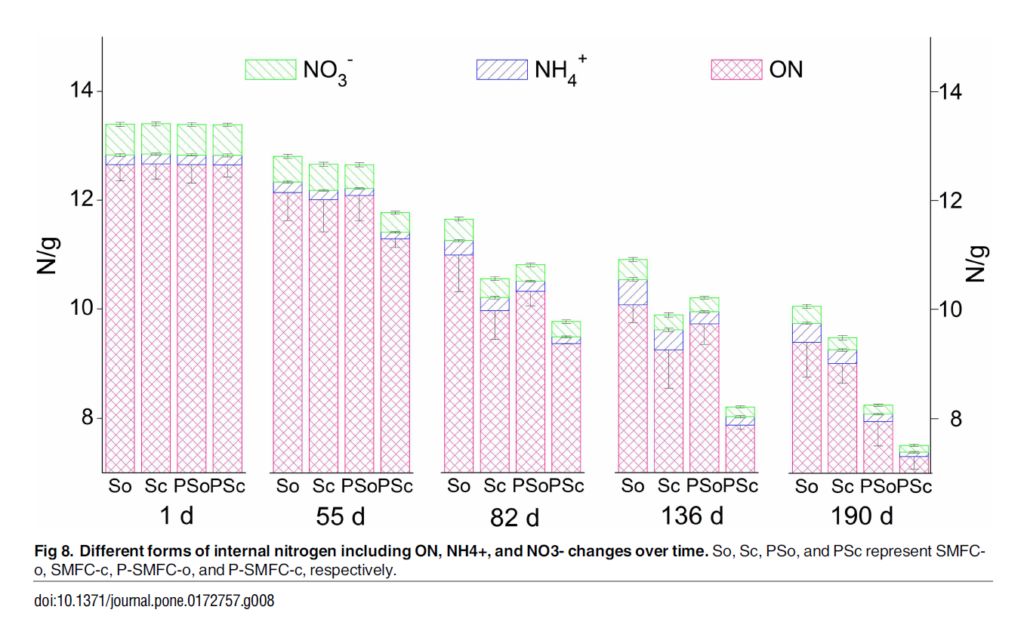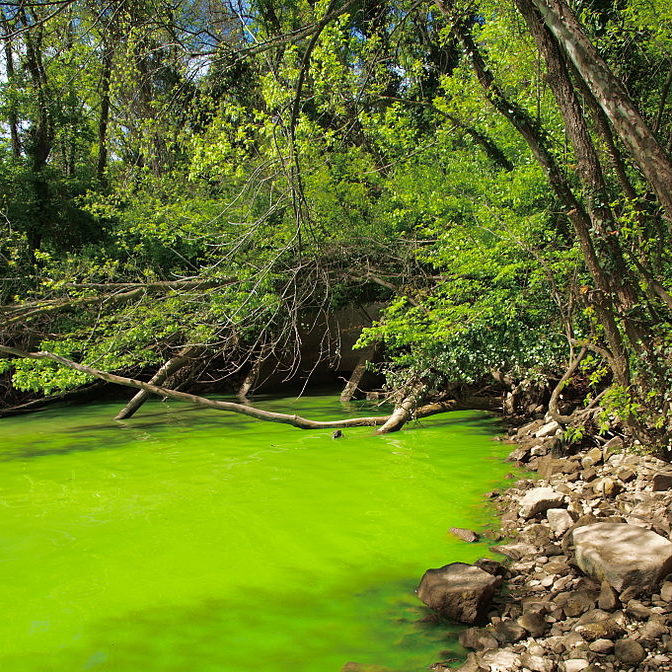Nitrogen pollution is a big problem in standing water such as lakes and ponds. The nitrogen comes from many sources, often agricultural fertilizers. Some of this nitrogen is in the water, but the rest of it is actually trapped in the sediment at the bottom of the lake. You can see evidence of this pollution when a green mat of algae, which loves nitrogen, forms over the surface of a pond. This is unhealthy for fish, because it starves them of oxygen.
An international group of scientists have decided to remedy the problem rather creatively. To decrease the amount of nitrogen in the sediment, they built microbial fuel cells, which are basically batteries powered by bacteria. They also wondered if combining the fuel cell with plants would speed up nitrogen removal even more. Plant roots harbor lots of useful bacteria that may help the fuel cell operate better, and also use some forms of nitrogen as fertilizer to build their body tissues.
They had to do this in a test setting rather than in a real lake to avoid accidental, unwanted environmental effects such as harm to wildlife habitat and other unknowns. They took small samples of sediment and water from a nearby lake for their indoor lab simulation. They tested four different types of fuel cells and repeated the test three times for a total of twelve tanks. They designed two types of circuits – an open and a closed circuit microbial fuel cell, with the positive terminal (the cathode) made from titanium wire and the negative terminal (the anode) made from carbon fiber. They also designed two more systems – an open and a closed circuit microbial fuel cell combined with a plant called Vallisneria spiralis, which is a common aquarium grass.

Fig 1. Schematic diagram of experimental devices including four treatments of SMFC-o, SMFC-c, P-SMFC-o, and P-SMFC-c. http://dx.doi.org/10.1371/journal.pone.0172757.g001
The way the fuel cell works is that the bacteria break down the organic matter in the sediment. When bacteria break down organic matter, they release electrons and generate an electric current along the battery’s wires. The electric current releases ammonium ions, a form of nitrogen, from the sediment at the bottom of the lake. Some types of bacteria break down the ammonium into the gas form of nitrogen so it bubbles out of the lake. The scientists believed that the plants will help speed up nitrogen removal by taking up some of that ammonium as fertilizer.
It turns out the scientists were correct! Adding aquatic plants to the fuel cells did speed up the removal of nitrogen from the water compared to just the fuel cell alone.
In the diagram below, you can see that the added aquatic plants reduced the nitrogen. The height of the bars corresponds to the amount of nitrogen in the tank. Since there were four different types of fuel cells, there is one bar for each tank. Then the amount of nitrogen was measured after 1 day, 55 days, 82 days, 136 days, and 190 days. As the days passed the amount of nitrogen was reduced in all tanks, with the most reduced in the closed circuit fuel cell with plants added.

Fig 2. The results of the nitrogen removal for the 4 different systems. http://dx.doi.org/10.1371/journal.pone.0172757.g001
What about electricity generation? This thing is a battery after all! All four types of fuel cells only generated a small amount of electricity, in the millivolts range, barely enough to power one LED light.
To understand the types of bacteria feeding the battery, the researchers used genetic technology called “high throughput sequencing” to identify the types of bacteria present in their fuel cells. This technology allows scientists to use the DNA found at the electrodes of the batteries to identify which kinds of bacteria are there! Since they designed their fuel cell to use the communities of microbes living in the natural lake, they were not sure what species were doing all of the work. It turns out, different bacterial species lived on the negative terminal compared to the positive terminal in the closed circuit fuel cell. That difference appeared to allow better nitrogen removal.
Nitrogen pollution is something that affects all of us. Without lakes and ponds, we harm our fish populations, which are a major source of recreation and food. The authors of this paper focused on sediment nitrogen, where most other studies have focused on the nitrogen pollution in the water. It is important to consider both. What is particularly interesting about this study is that the researchers found a way to not only remedy the pollution problem but also generate a small amount of electricity in the process. It’s possible that someday these technological advances could be scaled up, fulfilling both an energy need and an environmental need.


